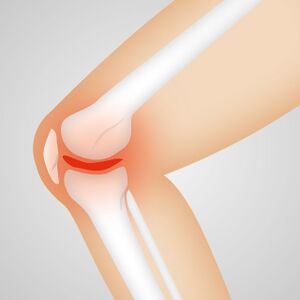Self-Management for Knee Osteoarthritis
Original Editor - Libby McConnell
Top Contributors - Libby McConnell and Kim Jackson
Introduction[edit | edit source]
Knee osteoarthritis (OA) is a degenerative joint disease which results in the gradual loss of articular cartilage. It is a painful, chronic condition that primarily effects elderly people. Clinical symptoms including knee pain, stiffness, and swelling, are associated with functional limitations, chronic pain and lower quality of life.[1]
According to the World Health Organisation (WHO) since 1990, there has been a 113% increase in the number of people living with osteoarthritis world wide. Due to the rise of an ageing population, chronic or long term conditions, such as OA are set to increase the burden on global healthcare.[2]
Conservative vs Operative Management[edit | edit source]
Unfortunately, there is no known cure for knee OA.
The tow main management pathways are conservative and operative. Self-management falls under the conservative pathway in addition to pharmaceutical options.
Self-Management[edit | edit source]
Self-management is described as "the individual's ability to manage the symptoms, treatment, physical and psychological consequences and lifestyle changes inherent in living with a chronic condition."[3]
Patient Self-management tools include a range skills which promote responsibility of individuals health.
Self-management has been shown to have a positive effect on the lives of those living with knee pain, increasing their confidence in managing their health and symptoms to significantly improve knee function, pain, stiffness and quality of life.[4]
Self-management tools[edit | edit source]
Self-management tools are all about building healthy habits.
- Exercise and physical activity
- Pacing and modification
- Healthy eating
- Weight management
- Pain medication
The Physiotherapist's role[edit | edit source]
Conclusion[edit | edit source]
Knee OA will continue to increase in prevalence as the elderly population continues to grow. New solutions are required to improve the function, overall wellbeing, and quality of life for those living with chronic conditions. Self-management has a lot to offer in addition to known treatment options. Physiotherapist's have an increasingly important role to play in supporting those living with knee OA to self-manage their conditions more effectively.
Resources[edit | edit source]
- 10 Self-care tips to take care of your arthritic pain - Arthritis foundation
- Arthritis foundation
- Managing your knee pain - Chartered Society of Physiotherapy
- Webinar on self-management for knee OA - Berkshire Healthcare
References[edit | edit source]
- ↑ Kawano MM, Araújo IL, Castro MC, Matos MA. Assessment of quality of life in patients with knee osteoarthritis. Acta ortopedica brasileira. 2015 Nov;23:307-10.
- ↑ World Health Organization. Osteoarthritis. Fact Sheet. [Internet]. 2021 [cited 2023 Nov 25]. Available from: https://www.who.int/news-room/fact-sheets/detail/osteoarthritis#:~:text=Osteoarthritis%20is%20chronic%20and%20often,cardiovascular%20diseases%2C%20obesity%20and%20diabetes.
- ↑ Barlow J, Wright C, Sheasby J, Turner A, Hainsworth J. Self-management approaches for people with chronic conditions: a review. Patient education and counseling. 2002 Oct 1;48(2):177-87.
- ↑ Wu Z, Zhou R, Zhu Y, Zeng Z, Ye Z, Wang Z, Liu W, Xu X. Self-Management for Knee Osteoarthritis: A Systematic Review and Meta-Analysis of Randomized Controlled Trials. Pain Res Manag. 2022;2022:2681240. doi:10.1155/2022/2681240.








